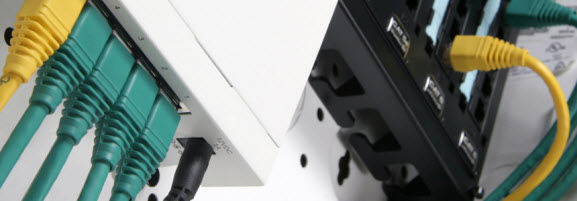
If you need to choose a router or a switch to set up a network for your business, what you will take into consideration? As we known, router and network switch are necessary computer networking devices. They allow one or more computers to be connected to other computers, networked devices, or to other networks. In fact, the functions of switches and routers are quite different, even if they are integrated into a single device at times. Routers connect two or more logical subnets, which do not necessarily map one-to-one to the physical interfaces of the router.

The layer 3 switch often is used interchangeably with router, but switch is really a general term without a rigorous technical definition. In marketing usage, it is generally optimized for Ethernet LAN interfaces and may not have other physical interface types.
A router is a more sophisticated device than a switch. Traditional routers are designed to join multiple area networks (LANs and WANs). Routers serve as intermediate destinations for network traffic. They receive TCP/IP packets, look inside each packet to identify the source and target IP addresses, and then forward these packets as needed to ensure the data reaches its final destination.
A network switch is a small hardware device that joins multiple computers together within one local area network (LAN). Switches are incapable of joining multiple networks or sharing an Internet connection. A home network with a switch must designate one computer as the gateway to the Internet, and that device must possess two network adapters for sharing, one for the home LAN and one for the Internet WAN. With a router, all home computers connect to the router equally, and it performs the equivalent gateway functions.
What is a Network Switch versus a Router? Switches create a network. Routers connect networks. A router links computers to the Internet, so users can share the connection. A router acts as a dispatcher, choosing the best path for information to travel so it’s received quickly. So a switch is used for wired networking connections. Routers can connect wired or wireless (WiFi) networks.
What the main different between routers and network switches? Here we list some main tips that may help you find a right router and switch for your network?
Router and Network Switch Comparison (with Examples of Cisco ISR G2 and Cisco layer3 Switches)
| Router | Switch | |
| Layer | Network Layer (Layer 3 devices) | Data Link Layer or Network Layer. Network switches operate at Layer 2/3 of the OSI model. |
| Ports | 2/4/8 | Switch is multi-port Bridge. 24/48 ports |
| Transmission Type | At Initial Level Broadcast then Uni-cast & Multicast | First broadcast; then unicast & multicast as needed. |
| Table | Store IP address in Routing table and maintain address at its own. | A network switch stores MAC addresses & IP address in a lookup table. |
| Device Type | Networking device | Active Device (With Software) & Networking device |
| Transmission Mode | Full duplex | Full duplex |
| Used in (LAN, MAN, WAN) | LAN, WAN | LAN, WAN |
| Broadcast Domain | In Router, every port has its own Broadcast domain. | Switch has one broadcast domain [unless VLAN implemented] |
| Data Transmission form | Packet | Frame (L2 Switch) Frame & Packet (L3 switch) |
| Function | Directs data in a network. Passes data between home computers, and between computers and the modem. | Allow to connect multiple device and port can be manage, Vlan can create security also can apply |
| Device Category | Intelligent Device | Intelligent Device |
| Bandwidth sharing | Bandwidth sharing is Dynamic (Enables either static or dynamic bandwidth sharing for modular cable interfaces. The default percent-value is 0. The percent-value range is 1-96.) | There no sharing port can be 10, 100, 1000 and 10000 Mbps individual |
| Speed | 1-10 Mbps(Wireless) 100 Mbps (Wired) | 10/100Mbps, 1Gbps |
| Routing Decision | Take faster Routing Decision | Take more time for complicated routing Decision |
| NAT (Network Address Translation) | Can Perform NAT | L3 Switches can perform NAT |
| Faster | In a different network environment (MAN/ WAN) Router is faster than L3 Switch. | In a LAN environment L3 switch is faster than Router (built in switching hardware) |
| Features | Firewall VPN Dynamic handling of Bandwidth | Priority rat range On/Off setting of port VLAN Port mirroring |
| Latest Models | Linksys WRT54GL Juniper MX & EX series Cisco 3900, 2900,1900 series | Alcatel’s OmniSwitch 9000; Cisco Catalyst switch 4500 and 6500(10 Gbps), |
| Used for | Connecting two or more networks | Connecting two or more nodes in the same network or different network |
| Address used for data transmission | Uses IP address | Uses MAC address & IP address |
| Definition | A router is a networking device that connects a local network to other local networks. At the Distribution Layer of the network, routers direct traffic and perform other functions critical to efficient network operation. | A network switch is a computer networking device that is used to connect many devices together on a computer network. A switch is considered more advanced than a hub because a switch will on send msg to device that needs or request it |
More Networking Tips you can visit: https://blog.router-switch.com/category/networking-2/
More Cisco Network and Router Topics:
Discussion: Router vs. Layer 3 Switches
WAYS to Help You Set Up Your Small, Medium and Large Networks
Switch Types and LAN Switching
Check Cisco Routers and Switches Using the IOS Environment Command


